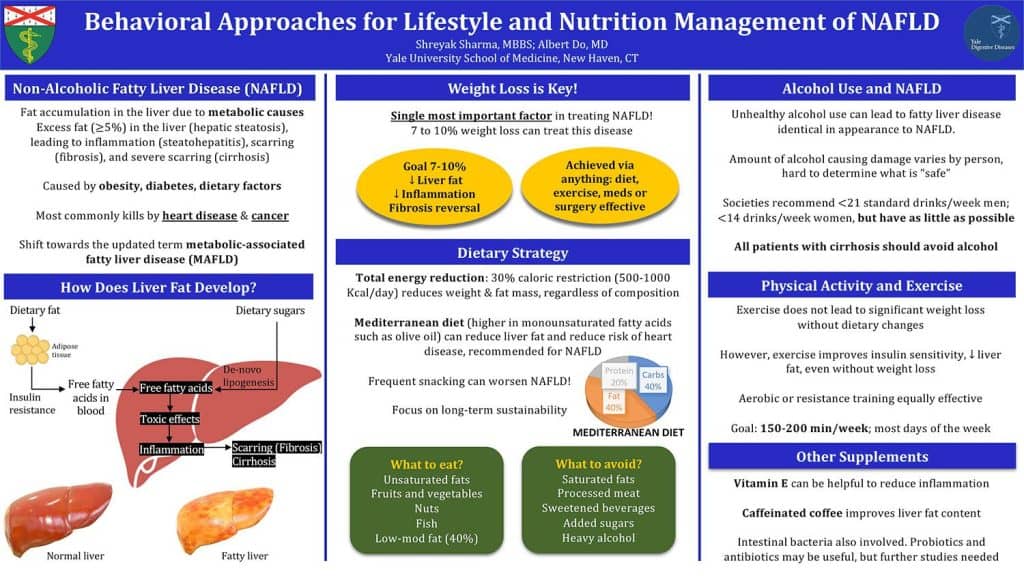Behavioral Approaches for Lifestyle and Nutrition Management of NAFLD
Shreyak Sharma, MD and Albert Do, MD
Yale University School of Medicine
This presentation is an excerpt from the ALF 2021 Poster Competition. This competition showcases posters and a brief video created by early career investigators from across the country on six areas of educational focus: fatty liver disease, liver cancer, liver transplantation, pediatric liver disease, rare liver disease and viral hepatitis. Participants are tasked with translating complicated medical information into a poster which can be easily understood by patients or the public. Posters are reviewed by a formal panel of judges comprised of Medical Advisory Council members, Board Members and friends of ALF to select a winner in each category.

NAFLD
Nonalcoholic fatty liver disease, or NAFLD, is a disease occurring when fat accumulates in the liver, due to chronic conditions like obesity, diabetes, high cholesterol, and diet.
Excess fat in the liver can lead to inflammation and liver scarring (called fibrosis), when scarring becomes severe, that condition is called cirrhosis. When we say cirrhosis, many think that alcohol is the only cause, but any chronic liver disease can lead to scarring and thus cirrhosis.
It is thought that 30% of the United States population has NAFLD, which is a tremendous number. Recently, the term “metabolic dysfunction associated fatty liver disease”, has been recommended.
Since obesity and diabetes are important related conditions, the most common causes of death in this population are heart disease and cancer.
How does fat accumulate in the liver?
There are 2 main ways that fat gathers in the liver. The first way is through fatty acids in the blood (similar to cholesterol) which the liver takes to become fat.
The second way is through dietary sugar intake, a process called de novo lipogenesis, where certain sugars that we eat is directly made in to liver fat.
Regardless of where the liver fat comes from, the concern is that once they get in, there fats can convert to a toxic form, leading to liver inflammation, scarring, and cirrhosis.
Weight Loss
Weight Loss is the single most important approach to manage and reverse fatty liver disease. Research has found losing 7-10% body weight loss reduces fat, inflammation, and reverses fibrosis.
For NAFLD, weight loss by any approach is effective, including medications or surgery.
Diet
For dietary strategies in NAFLD, aiming for total energy (calorie) restriction by 30% is recommended. This means reducing daily calorie intake by about 500 to 1000 calories each day.
Some research shows that a Mediterranean diet, which is a plant-based diet which is high in mono-unsaturated fatty acids like olive oil, nuts, fruits, vegetables, and fish can reduce liver fat, inflammation, diabetes, and even cardiovascular outcomes.
Certain behaviors have been found to make NAFLD worse, as well; like frequent snacking, sugary drinks, processed meat, saturated fats and foods with added sugars (especially fructose). These behaviors should be minimized whenever possible.
Alcohol
Alcohol use by itself causes fatty liver disease which can look identical to NAFLD. The challenge is that the amount it takes to cause this is unclear from person to person. There have been various recommendations, some recommending less than 21 standard drinks in men and 14 in females, which can be used as a rule of thumb. However, because we don’t necessarily know how much is safe, generally try to drink as little as possible. Those with advanced scarring or severe scarring (cirrhosis), should avoid alcohol altogether.
Exercise
It is important to know that physical activity and exercise generally do not lead to significant weight loss, and dietary changes are the most important behavior for weight loss. Regardless, exercise has been found to improve NAFLD, even if it does not lead to weight loss.
Aerobic or resistance training is equally effective, so whatever exercise is most enjoyable and sustainable is the most important thing.
Nutraceuticals
Finally, There are some supplements that can help in the management of FLD. Vitamin E (800 units a day) has been found to be effective in reducing inflammation in NAFLD. Caffeinated coffee can improve liver fat, but make sure to avoid the sugar and fatty cream which can lead to weight gain. The normal bacteria in our intestines, also known as the gut microflora, can be involved in NAFLD development, and probiotics may be effective, though more studies are needed.
In summary, there are many behaviors which we can do to prevent and to treat NAFLD, which include dietary changes for weight loss and sugar avoidance, alcohol reduction, exercise, and supplements.
Last updated on December 1st, 2022 at 11:42 am